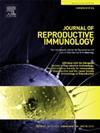Analysis and identification of potential biomarkers for dysfunctional uterine bleeding
IF 2.9
3区 医学
Q3 IMMUNOLOGY
引用次数: 0
Abstract
Clinical evidence increasingly suggests that traditional treatments for dysfunctional uterine bleeding (DUB) have limited success. In this study, blood samples from 10 DUB patients and 10 healthy controls were collected for transcriptome sequencing. Then, the differentially expressed genes (DEGs) were screened and crossed with the DUB-related module genes to obtain the target genes. These target genes were analyzed for functional enrichment. Further, the biomarkers were screened by protein-protein interaction (PPI) analysis and analyzed by the gene set enrichment analysis (GSEA) and ingenuity pathway analysis (IPA). To explore the pathogenesis of DUB, immune microenvironment analyses were also performed. Potential drugs targeting these biomarkers were predicted for clinical treatment. The expression of these biomarkers was validated using quantitative real-time polymerase chain reaction (qRT-PCR). The results showed that, a total of 754 target genes were found to be related to cell proliferation and senescence. Five biomarkers—CENPE, KIF11, PIK3R1, SMC3, and SMC4—were identified, all of which were down-regulated in the DUB group, and most of these findings were confirmed by qRT-PCR. Notably, CENPE expression showed a negative association with activated NK cells and a positive association with resting NK cells. In addition, 44 potential drugs were predicted for DUB treatment. In conclusion, five DUB biomarkers were identified, enhancing understanding of gene regulation in DUB and providing a theoretical foundation for clinical diagnosis and treatment.
求助全文
约1分钟内获得全文
求助全文
来源期刊
CiteScore
6.30
自引率
5.90%
发文量
162
审稿时长
10.6 weeks
期刊介绍:
Affiliated with the European Society of Reproductive Immunology and with the International Society for Immunology of Reproduction
The aim of the Journal of Reproductive Immunology is to provide the critical forum for the dissemination of results from high quality research in all aspects of experimental, animal and clinical reproductive immunobiology.
This encompasses normal and pathological processes of:
* Male and Female Reproductive Tracts
* Gametogenesis and Embryogenesis
* Implantation and Placental Development
* Gestation and Parturition
* Mammary Gland and Lactation.

 求助内容:
求助内容: 应助结果提醒方式:
应助结果提醒方式:


